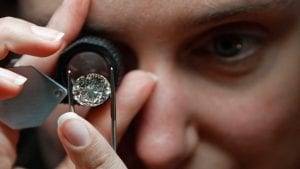 Diamonds. When they come to mind it’s hard to think of them without thoughts of glamour, romance, and wealth. For decades they have been the ultimate symbol of love, and the commercials which share they with the world have their slogans permanently fixed in our memories. Whether it’s a special ring in an aqua blue Tiffany Box, A kiss from Kay or just Jared, their hasn’t been a more universally popular stone. Today that continues to hold true. De Beers released a report showing Americans have spent over $41 billion on the precious stones alone in 2016. This is an increase from the previous year. It’s clear that Diamonds are still relevant, but are Diamond companies struggling to market them appropriately and to the right audience?
Diamonds. When they come to mind it’s hard to think of them without thoughts of glamour, romance, and wealth. For decades they have been the ultimate symbol of love, and the commercials which share they with the world have their slogans permanently fixed in our memories. Whether it’s a special ring in an aqua blue Tiffany Box, A kiss from Kay or just Jared, their hasn’t been a more universally popular stone. Today that continues to hold true. De Beers released a report showing Americans have spent over $41 billion on the precious stones alone in 2016. This is an increase from the previous year. It’s clear that Diamonds are still relevant, but are Diamond companies struggling to market them appropriately and to the right audience?
CNBC reported that Millennials in the US, China, Japan, and India spent $26 billion dollars on diamond jewelry in 2016. If this is the case, why have various media outlets such as The Economist and The Huffington Post reported on Millennial rejection of this industry. This generation is largely misunderstood and a large reason why may have to do with consistent comparison to their parents the baby boomers. This action is misleading because Baby boomers and millennials operate completely differently and care about different issues.
To answer this one must look at the overarching trends that affect this generation. It is increasingly becoming true that a company’s ethics can shift Millennial consumers interest in buying its products. According to a Forbes piece, “Millennials prefer to do business with corporations and brands with pro-social messages, sustainable manufacturing methods and ethical business standards.” These consumers care where there products are coming from which can definitely hurt the diamond industry with it’s history of unethical practices are brought to light. In particular, the 2006 movie titled Blood Diamond starring Leonardo Dicaprio brought this issue of conflict diamonds to mainstream pop culture. According to a Time.com piece conflict Diamonds are described as, “precious stones mined in African war zones, often by forced labor, and used to fund armed rebel movements.” Many companies including Tiffany, Signet and De Beers have been working to clean up their supply chains.
Another issue facing the Millennial sentiment towards diamonds is shifted monetary priorities. Student Loan debt is at an all time high for young people’s as tuition prices grow to more than they have ever been. With a hefty debt load, it makes diamonds seem less important to Millennial consumers as it might have been to their parents. However, Millennials are beneficiaries to the largest transfer of wealth in modern history. As Baby Boomers age, their children inherit their money which Investment News reports is up to $30 trillion.
Along with shifting monetary priorities comes a change in spending habits. Millennials value experiences over things. CNBC reported that this can affect many areas of the economy. Fashion and Jewelry in particular have been forced to adapt. They draw millennials in with experiential advertisements over traditional ones. Also, travel, concerts, and discovering new restaurants are areas where Millennials are spending most of their disposable income. Companies like Aeropostale and Abercrombie & Fitch faced bankruptcy because younger generations started caring less about labels and brand names.
An area that is worth studying that can affect the psychology of these young potential diamond consumers is psychology. In particular, psychology relating to marriage and this generation’s view of it. A recent Gallup poll revealed that 86% of never married people between the ages of 18-34 want to get married one day. This poll indicates the strong interest in marriage, but perhaps there is another reason why millennial’s sentiment towards Diamonds isn’t as strong as other generations. According to a Thought Catalog piece, the answer is very simple. Millennials have redefined the meaning of marriage and are seeking for something deeper. As a group, Millennials wait until they are a lot older to get married than their parents and the generation before them ever did. Diamonds and their interest can be tied directly to this. Although Diamond sales have not decreased, the time in their life that they are being purchased (marriage) by this group has most likely changed significantly.
Are diamonds still a girl’s best friend? For the younger generation, this concept is constantly changing proving to be less true than with older people’s. It’s not diamonds that are going out of style. It is the way they are sold and the time they are traditionally bought that must be reevaluated. To stay relevant in this time where Millennials are beginning to reign supreme, the Diamond industry is forced to adapt or become obsolete like other fashion and jewelry related retailers. What is in store for the future of the diamond industry? That is something only time can tell.
If you would like to contribute an article or contact our contributors, you can get in touch here
